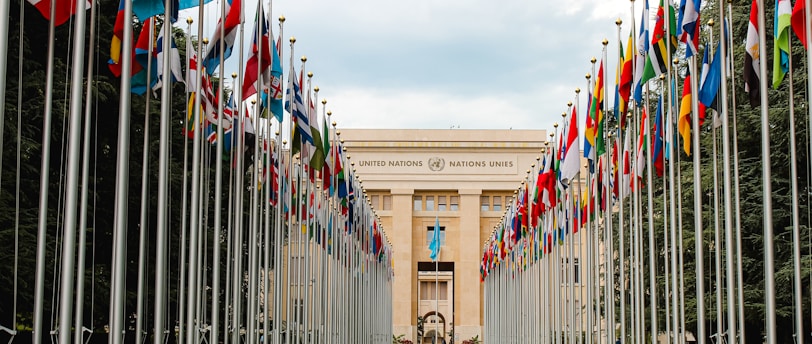The Sustainable Development Goals: A Comprehensive Guide
The Sustainable Development Goals (SDGs) are a set of 17 goals that aim to make the world a better place by 2030. This blog post provides a comprehensive guide to the SDGs, including what they are, why they are important, and how you can help achieve them.
9/15/20235 min read


Introduction
The Sustainable Development Goals (SDGs) are a set of 17 goals that were adopted by the United Nations in 2015. The goals aim to end poverty, protect the planet, and ensure that all people enjoy peace and prosperity by 2030.
The SDGs are ambitious, but they are also achievable. They are based on the principle that everyone has a role to play in making the world a better place.
The SDGs
The 17 SDGs are:
No poverty
Zero hunger
Good health and well-being
Quality education
Gender equality
Clean water and sanitation
Affordable and clean energy
Decent work and economic growth
Industry, innovation and infrastructure
Reduced inequalities
Sustainable cities and communities
Responsible consumption and production
Climate action
Life below water
Life on land
Peace, justice and strong institutions
Partnerships for the goals
The SDGs are interconnected. This means that progress on one goal can help to achieve progress on other goals. For example, reducing poverty can help to improve health and education, and protecting the environment can help to create jobs and reduce conflict.
Why the SDGs are Important
The SDGs are important because they address the most pressing challenges facing the world today. These challenges include poverty, hunger, disease, climate change, and inequality. The SDGs provide a framework for addressing these challenges and building a better future for all.
Here are some stats and data from India and around the world regarding the Sustainable Development Goals:
India
Poverty: India has made significant progress in reducing poverty in recent years. The poverty rate has fallen from 42% in 2005 to 21% in 2019. However, there are still millions of people living in poverty in India.
Hunger: India has also made progress in reducing hunger. The proportion of people who are undernourished has fallen from 22% in 2005 to 14% in 2019. However, there are still millions of people who are undernourished in India.
Health: India has made progress in improving health outcomes. The under-five mortality rate has fallen from 90 per 1,000 live births in 2005 to 38 per 1,000 live births in 2019. However, there are still many challenges to overcome in terms of health in India.
Education: India has made progress in increasing access to education. The net enrollment rate in primary school has reached 97%, and the net enrollment rate in secondary school has reached 74%. However, there are still many challenges to overcome in terms of education in India, such as the quality of education and the dropout rate.
Gender equality: India has made progress in achieving gender equality. The gender gap in literacy has narrowed, and the number of girls enrolled in school has increased. However, there are still many challenges to overcome in terms of gender equality in India, such as the high rates of violence against women and girls.
Clean water and sanitation: India has made progress in providing access to clean water and sanitation. The proportion of people with access to improved drinking water has reached 90%, and the proportion of people with access to improved sanitation has reached 70%. However, there are still many challenges to overcome in terms of clean water and sanitation in India, such as the quality of water and the lack of sanitation facilities in rural areas.
Affordable and clean energy: India has made progress in increasing access to affordable and clean energy. The proportion of people with access to electricity has reached 98%, and the proportion of people using clean cooking fuels has increased. However, there are still many challenges to overcome in terms of affordable and clean energy in India, such as the high cost of energy and the lack of access to clean cooking fuels in rural areas.
Worldwide
Poverty: The global poverty rate has fallen from 10% in 1990 to 7% in 2019. However, there are still 689 million people living in extreme poverty.
Hunger: The proportion of people who are undernourished has fallen from 23% in 1990 to 11% in 2019. However, there are still 821 million people who are undernourished.
Health: The under-five mortality rate has fallen from 90 per 1,000 live births in 1990 to 38 per 1,000 live births in 2019. However, there are still many challenges to overcome in terms of health, such as the HIV/AIDS epidemic and the spread of non-communicable diseases.
Education: The net enrollment rate in primary school has reached 91%, and the net enrollment rate in secondary school has reached 75%. However, there are still many challenges to overcome in terms of education, such as the high rates of illiteracy and the lack of access to quality education in rural areas.
Gender equality: There has been progress in achieving gender equality, but there are still many challenges to overcome. For example, the gender gap in wages remains wide, and women are still underrepresented in leadership positions.
Clean water and sanitation: The proportion of people with access to improved drinking water has reached 71%, and the proportion of people with access to improved sanitation has reached 54%. However, there are still many challenges to overcome in terms of clean water and sanitation, such as the lack of access to clean water and sanitation in rural areas and conflict-affected areas.
Affordable and clean energy: The proportion of people with access to electricity has reached 89%. However, there are still many challenges to overcome in terms of affordable and clean energy, such as the high cost of energy and the lack of access to clean energy in rural areas.
These are just a few examples of the stats and data from India and around the world regarding the Sustainable Development Goals. There is still much work to be done to achieve these
How You Can Help
There are many ways you can help achieve the SDGs. Here are a few ideas:
Educate yourself about the SDGs and what you can do to help. There are many resources available to help you learn about the SDGs. You can find information on the United Nations website, in books and articles, and from organizations that are working to achieve the SDGs.
Talk to your friends and family about the SDGs and encourage them to get involved. The more people who know about the SDGs, the more likely we are to achieve them.
Make changes in your own life to live more sustainably. This could mean things like eating less meat, recycling more, or using less energy.
Support businesses that are committed to sustainability. When you buy products from businesses that are committed to sustainability, you are helping to support their efforts to make a difference.
Get involved in your community and volunteer for an organization that is working to achieve the SDGs. There are many organizations that are working to achieve the SDGs. You can find organizations in your area by searching online or asking your friends and family for recommendations.
Conclusion
The SDGs are a blueprint for a better future. By working together, we can make the world a more sustainable and equitable place for all.
SEO Keywords
sustainable development goals
SDGs
green goods
sustainable lifestyle
climate action
environmental sustainability
poverty alleviation
gender equality
clean water
renewable energy
responsible consumption
peace and justice
We hope this blog post has been helpful. Thank you for reading!
